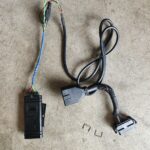Experiencing issues connecting your diagnostic scanner to your 2001 Ford Explorer? A common frustration for DIY mechanics and car enthusiasts is encountering a no power situation at the OBD2 port, preventing essential vehicle diagnostics. If you’re facing a “computer failed to communicate” message during a vehicle inspection or your scanner won’t power up when plugged into your Ford Explorer’s OBD2 port, you’re in the right place. This guide will walk you through troubleshooting steps to pinpoint why your 2001 Ford Explorer OBD2 connector might be powerless.
Understanding the OBD2 Port and Power Requirements
The On-Board Diagnostics II (OBD2) port, also known as the Data Link Connector (DLC), is crucial for accessing your vehicle’s computer system for diagnostics and emission testing. For your scan tool to communicate with your 2001 Ford Explorer’s computer, the OBD2 port needs proper power and ground connections. Pin 16 of the OBD2 connector should provide battery voltage, while pins 4 and 5 are designated grounds. Let’s delve into how to systematically check these connections.
Checking for Power and Ground at the OBD2 Port
The first step in diagnosing a powerless OBD2 port is to verify the power and ground circuits. You’ll need a multimeter for these tests.
Power Check (Pin 16):
- Set your multimeter to DC Voltage.
- Ground the negative probe of your multimeter to a known good ground on the vehicle chassis.
- Probe pin 16 of the OBD2 connector with the positive probe.
- You should read battery voltage (approximately 12V) with the ignition both on and off.
If you’re not getting battery voltage at pin 16, the issue likely lies within the power supply circuit to the OBD2 port. This could involve checking fuses and wiring related to the OBD2 system.
Ground Check (Pins 4 & 5):
- Keep your multimeter set to DC Voltage.
- Connect the positive probe of your multimeter to pin 16 (which we’ve confirmed has power).
- Probe pin 4 and then pin 5 with the negative probe.
- For both pins 4 and 5, you should also read battery voltage. This is because you are completing a circuit through the ground pins. A lack of voltage here indicates a ground issue.
High resistance or a lack of voltage on pins 4 or 5 indicates a problem with the ground connections G100 and G101, typically located near the radiator on the left side and on the left fender, respectively, in a 2001 Ford Explorer.
Testing Communication Pins and Further Diagnostics
Beyond power and ground, communication pins are essential for data transfer between your scanner and the vehicle’s computer.
Communication Pin Checks (Pins 2, 10, 13):
While voltage checks on these pins might not yield definitive results without an oscilloscope, you can perform resistance tests to check for continuity between the OBD2 connector and the ECU (Engine Control Unit).
- Disconnect the negative battery terminal.
- Locate the ECU and identify the corresponding pins for data bus (+) (Pin 2), data bus (-) (Pin 10), and programming signal (Pin 13) – your vehicle’s wiring diagram is crucial here. The original post mentions pins 15 or 16 for data bus connections and pin 13 for programming signal on the ECU.
- Set your multimeter to Ohms or continuity test.
- Test for resistance between:
- OBD2 Pin 2 and ECU Data Bus (+) pin
- OBD2 Pin 10 and ECU Data Bus (-) pin
- OBD2 Pin 13 and ECU Programming Signal pin
- Resistance should be very low, ideally under 0.5 ohms, indicating good wire continuity.
Pin 7 (K-Line) Check:
Pin 7 is often used for communication in older OBD2 systems (K-Line). The original post mentions it connects to systems like ABS, airbag, and locks. While direct testing might be complex without specific diagrams and equipment, ensure there’s no obvious damage or corrosion on the pin and its associated wiring.
Possible Causes and Solutions for a Powerless OBD2 Port
Based on the checks performed, here are potential causes and solutions for a no power OBD2 port in your 2001 Ford Explorer:
- Blown Fuse: This is the most common culprit. Check the fuse box (often located inside the cabin and under the hood) for fuses related to the diagnostic system or cigarette lighter/accessory power, as they can sometimes share circuits. Replace any blown fuses with the correct amperage rating.
- Wiring Issues: Damaged, corroded, or shorted wires can disrupt power or ground to the OBD2 port. Inspect the wiring harness leading to the OBD2 connector for any visible damage. Pay close attention to ground points G100 and G101 for corrosion or loose connections.
- Faulty OBD2 Connector: While less common, the OBD2 connector itself can be damaged or have corroded pins, preventing proper contact. Inspect the connector for physical damage and clean the pins if necessary.
- ECU Issue (Less Likely): In rare cases, an issue with the ECU itself might prevent communication. However, rule out power, ground, and wiring issues first before suspecting ECU problems.
Conclusion
Troubleshooting a powerless OBD2 port requires a systematic approach, starting with verifying power and ground, then checking wiring continuity. By following these steps and utilizing a multimeter and your 2001 Ford Explorer’s wiring diagram, you can effectively diagnose and resolve the issue, enabling you to connect your diagnostic scanner and proceed with vehicle maintenance or inspections. If you’re uncomfortable performing these tests, consulting a professional mechanic is always a reliable option.
